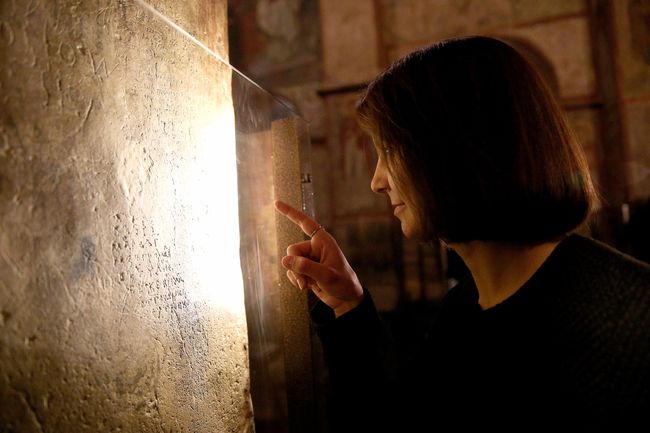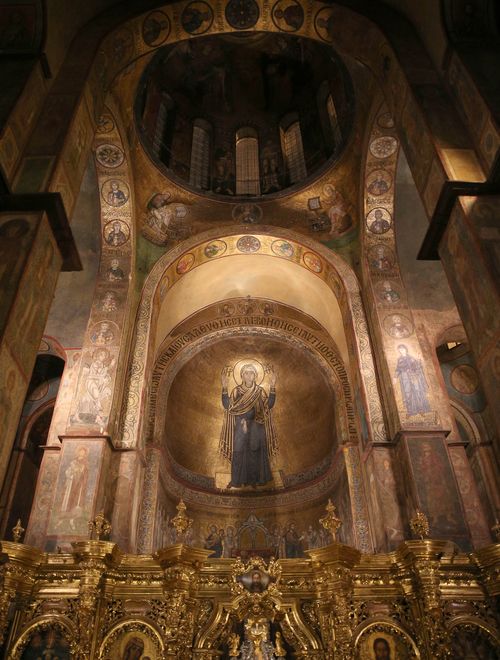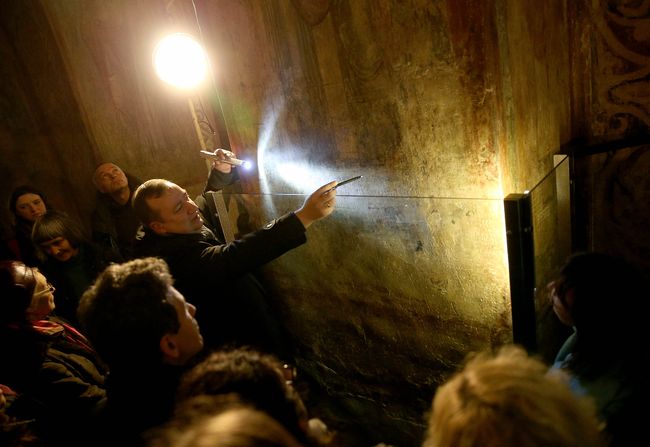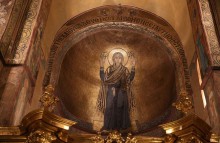The National Sanctuary Sophia of Kyiv recently invited art lovers to a unique excursion. With a flashlight in hand, historian Viacheslav Korniienko, the sanctuary’s deputy director general, deciphers to visitors some informal inscriptions scratched on the walls of St. Sophia’s Cathedral many centuries ago. We decided to seize this opportunity to clear up the mysteries of Ancient Rus’ graffiti.
PROVING THE ANTIQUITY OF THE OLD UKRAINIAN LANGUAGE
The first informal inscriptions on the monument’s walls appeared as long ago as the 11th century. Those who made them – priests, altar boys, pupils, or scriptorium clerks – might have been at the cathedral not only during the service. Most of them are on frescoed walls approximately at the height of a person. Yet the masters who worked almost under the domes would also leave their inscriptions there. Formally, it was forbidden to inscribe the walls on pain of 20 lashes. Either the rules were not observed or the inscriptions’ authors were too bold, but words were scratched with needles, knives, styluses, awls, etc. Some of the inscriptions are clearly seen without side lighting, which means they were not made stealthily.
Medieval art was usually anonymous, but some graffiti show their authors’ names. Women also made inscriptions in the cathedral. Girls were not allowed here before and after a service. The only exception was women from influential families, perhaps even relatives of the prince. So they may have scribbled some of the graffiti.
Most of the inscriptions are in the Old Ukrainian language. People used Cyrillic, but the oldest inscriptions are in Glagolitic. The Greek, Armenian, Latin, and German languages also occur. There is even a Runic inscription on the sarcophagus, but it must have been made outside the cathedral.

“It was considered previously that the Old Ukrainian language emerged in the 14th century and gradually transformed into Ukrainian. This followed, in particular, from the theories about the ‘cradle of fraternal peoples’ and the common Old Rus’ language which split after the Tatar-Mongol invasion. Besides, very few pre-Mongolian written monuments have survived in contrast to 14th-century manuscripts which show some features of the Ukrainian language. It was found during the examination of St. Sophia’s Cathedral graffiti that all these features had already existed back in the 11th century. In other words, the Old Ukrainian language had already formed by that time,” Korniienko says.
A THOUSAND-YEAR-OLD CONTRACT
Most of the wall inscriptions are commemorations and prayers. History was considered sacred in the Middle Ages, so people wanted to leave a trace in it. And a cathedral, which has survived a great number of wars and governments, is by far the best place for doing so. Researchers have also found a terrible exception among the inscriptions – a curse, in which an aggrieved person wishes his offender, who stole his meat, to be hobbled.
One of the best-known graffiti, about the burial of Yaroslav the Wise, began to be explored in the mid-20th century. The inscription helped historians clear up the confusion in chronicles and find out the exact dates of the prince’s death and funeral – February 19 and 20, 1054, respectively.

Some of the cathedral’s frescos hold a record in the number of inscriptions. The leader is the image of St. Onuphrius, which has about 200 graffiti. Among them is a land purchase contract concluded in the 11th century. It is incredible: almost a thousand years have passed, and neither the buyer nor the seller is here, but the document still exists!
The fresco that depicts Basil the Great notes a no less important piece of information – the expected dates of the end of the world. The years 1022, 1033, and 1036 occur in various chronicles, but they are indicated all together here.
CARICATURES, PARODIES, EXERCISES
You can see a lot of drawings on the cathedral’s walls. As they are usually rather primitive, the authors added some “cues” for a better understanding, such as “moo” to a cow or “eeyore” to a saddled animal. One of the drawings stirred up a lively “discussion.” A man named Foma drew a little dog, someone else disclosed the author and signed the drawing, and third author crossed all this out with gestures of blessing, as if hinting that one must do something else in a temple.

Standing out among the inscriptions are prototypes of literary works, for example, reconsiderations of the texts of various services or fragments of the story about a she-goat that wanted to succumb to the devil. Next to it are Slavic alphabet letters, and exercises for pupils who went to the cathedral’s school. There were also caricatures of teachers and unfriendly parodies that depicted those who go to war as wicked and worthless.
A UNIQUE HISTORICAL SOURCE
The St. Sophia’s Cathedral graffiti began to be examined back in the 1920s, but those materials have been lost. A commission with Boris Rybakov at the head resumed the research in 1944. His follower was Sergey Vysotsky who explored the inscriptions for 23 years and devoted three books to this. A little more than 300 graffiti were studied in that period of time, while, in reality, there are about 7,000 of them.

Korniienko has been researching the cathedral’s inscriptions since 2006. In 2010 he began to publish the complete corpus of the Sophia of Kyiv graffiti. Six out of twelve volumes have already seen the light of day, and three of them can be viewed in the Internet.
“Cathedral inscriptions are the only source that shows a profile of the culture of the broad strata of the population in that era,” the researcher says convincingly. “By profoundness, they are not inferior to literary monuments or other documents of that time. All we should do is to choose an angle of view that will allow getting as much information as possible to continue the research.”








